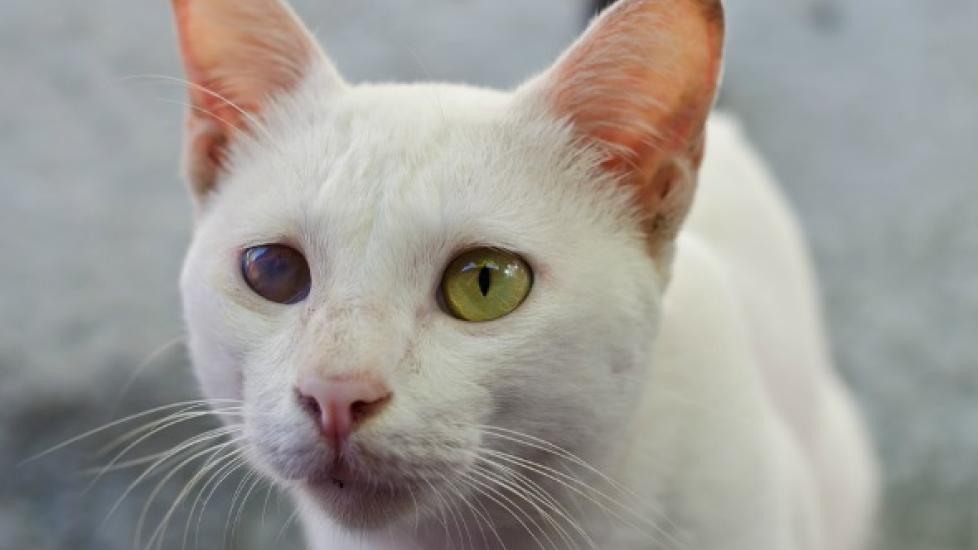Eye Injuries in Cats
Corneal and Scleral Lacerations in Cats
In medical terms, a penetrating injury is a wound, or a foreign object that enters the eye but does not completely pass through the cornea or sclera. A perforating injury, on the other hand, is a wound or foreign body that completely passes through the cornea or the sclera. Needless to say, the latter injury is a greater risk to vision. The cornea is the transparent outer layer at the front (anterior) of the eye. The sclera, the white of the eye, is composed of a tough covering that protects the eyeball.
Again in medical terms, a simple injury involves only the cornea or sclera and may be penetrating or perforating. Other eye structures are not injured in a simple injury. A complicated injury perforates the eye and involves other eye structures in addition to the cornea or sclera. In fact, it can affect one or all parts of the eye. The entire middle layer of the eyeball that contains the blood vessels, and which is composed of the iris, the area between the iris, and the choroid - - the layer between the sclera and the retina - - can be injured by a complicated perforating injury. There may also be trauma to the lens, which can lead to cataracts or lacerations to the eyelid.
Symptoms and Types
Symptoms of an injury to the eyeball may be represented by the suddenness of the symptoms (e.g., pawing at the eye, blinking rapidly, swelling, inflammation), as well as the following symptoms, any of which may be indicative of an injury to the eye:
- Blood in the eye, or a blood filled mass (subconjunctival hematoma) left from a sealed laceration
- A foreign object in the eye that can be visually detected
- The pupil is distorted, either reacting abnormally or shaped differently
- The cornea, is clouded (cataract)
- The eye is protruding
Causes
Some of the most common occurrences that lead to an eye injury follow:
- When your pet has been running through heavy vegetation
- Gunshot, fireworks, or other rapid projectiles in the vicinity of your pet
- Pre-existing visual impairment or deformity in the structure of the eye
- Young, naive, or highly excitable animals that have not learned caution
- Fights with other animals; most notably cats, which will scratch at the faces of other animals
Diagnosis
If your veterinarian finds a foreign object in your cat's eye, appropriate treatment will be determined. The nature, force, and direction of the object's impact will help to identify which tissues may be involved. The visual response to a menace (i.e, blinking in response to an object being brought close to the eye), as well as aversion to bright light, will be assessed. The pupils will be examined for size, shape, symmetry, and light reflexes. If a foreign object is not found, your veterinarian will consider an ulcer of the cornea, or some other naturally occurring cause that is affecting the eye, before looking into the internal parts of the eye for trauma.
Treatment
The course of treatment will depend on the severity of the injury and the part of the eye that was injured. If the wound is non-perforating and has no wound edge or opening, an Elizabethan collar will be used to prevent your cat from scratching at its eye, along with antibiotic or atropine eye solutions. Non-perforating wounds that have a mild break in the tissue, or a pinpoint wound perforation, may be treated with a soft contact lens, an Elizabethan collar, and antibiotic or atropine solutions.
Injuries requiring surgical exploration or repair:
- Full-thickness corneal lacerations
- Full-thickness wounds with iris involvement
- Full-thickness scleral or corneoscleral lacerations
- Retained foreign object or a posterior scleral (white of the eye) rupture
- Simple nonperforating wound with edges that are moderately or overtly broken, and that are long, or more than two-thirds the corneal thickness
Most of the time, a cornea that has been lacerated due to injury, or has retained a foreign object, is salvageable. However, the further back, or deeper the injury, the poorer the prognosis for retention of vision. Cases that would warrant a poor prognoses, for example, would be an injury to the white, outer membrane of the eyeball, the sclera, or to the fluid part, the vascular layer of the eyeball. If there is no light perception, it may be due to a perforated injury involving the lens; a significant hemorrhage in the vitreous, the clear gel that fills the space between the lens and the retina of the eyeball; or, from retinal detachment. Penetrating injuries usually have a better prognosis then perforating injuries, and blunt traumas carry a poorer prognosis than sharp traumas.
Under most circumstances, your veterinarian will prescribe medications that are suitable to the seriousness of the wound. Antibiotics are usually prescribed, as well as anti-inflammatory medications and analgesics for pain.
Living and Management
Deep or wide penetrating wounds that have not been sutured will need to be rechecked every 24 to 48 hours for the first several days. If the penetrating wound is superficial, rechecking every three to five days until it is healed is sufficient.
As to prevention, take care when introducing new pets into the home if you already have a cat. Shows of authority by the established cat, or aggressive attempts at displacing the “head” cat by the newcomer can result in unintentional injuries. Also, as much as possible, discourage your pet from running through dense vegetation. If you are in an area that carries the risk of having debris transmitted to the eyes, like wooded areas, beaches, etc., it would be a good idea to have a bottle of saline eyewash to irrigate foreign debris from the eye.
